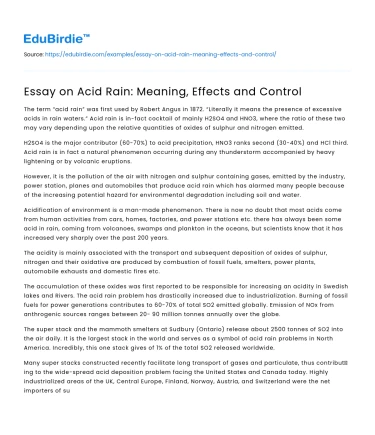The term “acid rain” was first used by Robert Angus in 1872. “Literally it means the presence of excessive acids in rain waters.” Acid rain is in-fact cocktail of mainly H2SO4 and HNO3, where the ratio of these two may vary depending upon the relative quantities of oxides of sulphur and nitrogen emitted.
H2SO4 is the major contributor (60-70%) to acid precipitation, HNO3 ranks second (30-40%) and HCl third. Acid rain is in fact a natural phenomenon occurring during any thunderstorm accompanied by heavy lightening or by volcanic eruptions.
Save your time!
We can take care of your essay
- Proper editing and formatting
- Free revision, title page, and bibliography
- Flexible prices and money-back guarantee
However, it is the pollution of the air with nitrogen and sulphur containing gases, emitted by the industry, power station, planes and automobiles that produce acid rain which has alarmed many people because of the increasing potential hazard for environmental degradation including soil and water.
Acidification of environment is a man-made phenomenon. There is now no doubt that most acids come from human activities from cars, homes, factories, and power stations etc. there has always been some acid in rain, coming from volcanoes, swamps and plankton in the oceans, but scientists know that it has increased very sharply over the past 200 years.
The acidity is mainly associated with the transport and subsequent deposition of oxides of sulphur, nitrogen and their oxidative are produced by combustion of fossil fuels, smelters, power plants, automobile exhausts and domestic fires etc.
The accumulation of these oxides was first reported to be responsible for increasing an acidity in Swedish lakes and Rivers. The acid rain problem has drastically increased due to industrialization. Burning of fossil fuels for power generations contributes to 60-70% of total SO2 emitted globally. Emission of NOx from anthrogenic sources ranges between 20- 90 million tonnes annually over the globe.
The super stack and the mammoth smelters at Sudbury (Ontario) release about 2500 tonnes of SO2 into the air daily. It is the largest stack in the world and serves as a symbol of acid rain problems in North America. Incredibly, this one stack gives of 1% of the total SO2 released worldwide.
Many super stacks constructed recently facilitate long transport of gases and particulate, thus contributing to the wide-spread acid deposition problem facing the United States and Canada today. Highly industrialized areas of the UK, Central Europe, Finland, Norway, Austria, and Switzerland were the net importers of sulphur compounds which contribute much for increasing acidity.






 Stuck on your essay?
Stuck on your essay?

